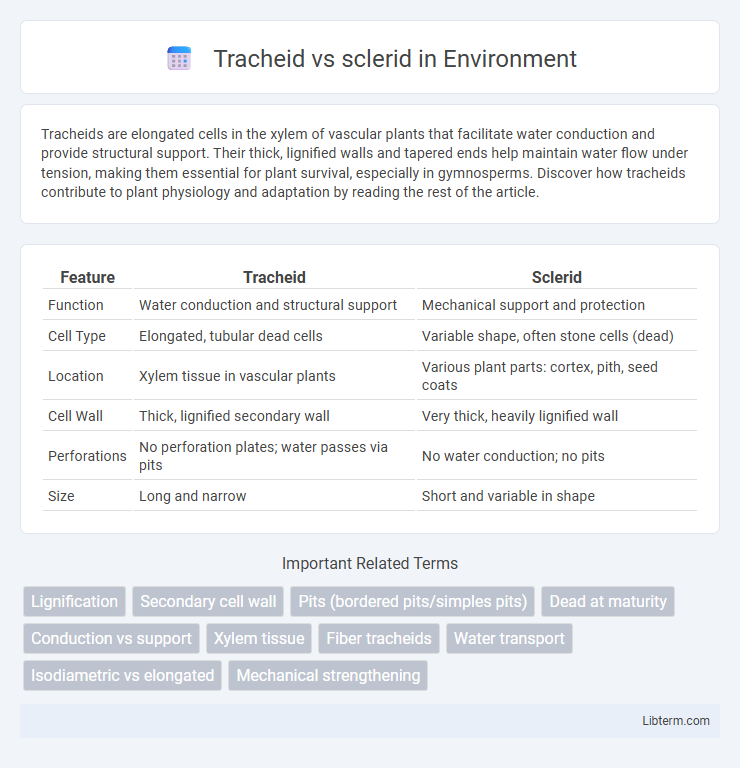Tracheids are elongated cells in the xylem of vascular plants that facilitate water conduction and provide structural support. Their thick, lignified walls and tapered ends help maintain water flow under tension, making them essential for plant survival, especially in gymnosperms. Discover how tracheids contribute to plant physiology and adaptation by reading the rest of the article.
Table of Comparison
| Feature | Tracheid | Sclerid |
|---|---|---|
| Function | Water conduction and structural support | Mechanical support and protection |
| Cell Type | Elongated, tubular dead cells | Variable shape, often stone cells (dead) |
| Location | Xylem tissue in vascular plants | Various plant parts: cortex, pith, seed coats |
| Cell Wall | Thick, lignified secondary wall | Very thick, heavily lignified wall |
| Perforations | No perforation plates; water passes via pits | No water conduction; no pits |
| Size | Long and narrow | Short and variable in shape |
Introduction to Plant Cells: Tracheids and Sclerids
Tracheids and sclerids are specialized plant cells that serve distinct structural and functional roles within vascular plants. Tracheids, elongated and hollow with thickened lignified walls, primarily facilitate water conduction and provide support in xylem tissues. Sclerids, shorter and irregularly shaped with heavily lignified walls, contribute to mechanical protection and structural reinforcement in various plant parts such as nutshells and seed coats.
Tracheids: Structure and Function
Tracheids are elongated, tubular cells with thick, lignified walls and tapered ends that facilitate water conduction and support within vascular plants, especially gymnosperms. Their bordered pits allow efficient water transport while minimizing air embolism risks, crucial for maintaining xylem functionality. Unlike sclerids, which primarily provide mechanical support and protection, tracheids play a key role in the plant's hydraulic system by enabling upward water movement and structural integrity.
Sclerids: Structure and Function
Sclereids possess thick, lignified cell walls that provide mechanical support and protection in plants, often forming gritty textures in fruits like pears. These cells exhibit variable shapes, including branched or isodiametric forms, contributing to the hardness and durability of seed coats and nutshells. Their primary function centers on reinforcing plant tissues and deterring herbivory through structural fortification.
Key Differences Between Tracheids and Sclerids
Tracheids are elongated, tube-like cells primarily involved in water conduction and support within xylem tissue, characterized by their thick, lignified walls and tapered ends. Sclerids, or stone cells, are shorter, variable-shaped cells with highly lignified walls that provide mechanical protection and structural support in various plant tissues such as seed coats and nutshells. Unlike tracheids which facilitate water transport, sclerids primarily contribute to plant defense and rigidity without conducting fluids.
Role of Tracheids in Water Conduction
Tracheids are elongated, tubular cells with thickened, lignified walls that play a crucial role in water conduction and structural support in vascular plants, especially gymnosperms. Their pits allow water to move efficiently between cells while minimizing air embolism, ensuring consistent water transport from roots to leaves. In contrast, sclereids primarily provide mechanical strength and protection without involvement in water conduction.
Role of Sclerids in Plant Support and Protection
Sclerids are specialized sclerenchyma cells that provide mechanical support and protection by reinforcing the plant's tissue with their thick, lignified walls. Unlike tracheids, which primarily function in water conduction and structural support within xylem, sclerids contribute mainly to defense against herbivory and physical damage by forming hard, gritty textures in fruits and seed coats. Their diverse shapes and dense arrangement enable sclerids to enhance rigidity and durability across various plant organs.
Anatomical Locations of Tracheids and Sclerids
Tracheids are elongated, tubular cells primarily found in the xylem of vascular plants, where they function in water conduction and structural support. Sclerids, or stone cells, are shorter, irregularly shaped sclerenchyma cells commonly located in the cortex, pith, and various protective tissues such as seed coats and fruit flesh. Tracheids dominate the secondary xylem, whereas sclerids typically occur in ground tissue and contribute to the hardness of seeds and fruits.
Evolutionary Significance of Tracheids and Sclerids
Tracheids represent an essential evolutionary advancement in vascular plants, facilitating efficient water conduction and structural support, which enabled the colonization of terrestrial environments. Sclerids, on the other hand, evolved primarily for mechanical protection and defense, contributing to plant durability and resistance against herbivory and environmental stress. The divergent functions of tracheids and sclerids highlight their complementary roles in plant adaptation, with tracheids optimizing hydraulic conductivity and sclerids enhancing tissue toughness and longevity.
Tracheids vs Sclerids: Comparative Table
Tracheids are elongated cells found in xylem tissue, primarily responsible for water conduction and structural support in vascular plants. Sclerids, commonly found in the sclerenchyma, are shorter, irregularly shaped cells that provide mechanical protection and rigidity. Compared in a table, tracheids feature thick lignified walls and tapering ends for efficient water transport, whereas sclerids have varied shapes with thick, lignified walls but serve primarily as protective and supportive cells rather than conduits.
Conclusion: Tracheid and Sclerid Contributions to Plant Physiology
Tracheids and sclerids both play essential roles in plant physiology by providing structural support and facilitating water conduction. Tracheids are elongated cells that primarily contribute to water transport and mechanical strength in xylem tissue. Sclerids, with their thick, lignified walls, enhance protection and structural rigidity, particularly in seed coats and fruit walls, highlighting their complementary functions in plant survival and adaptation.
Tracheid Infographic

 libterm.com
libterm.com